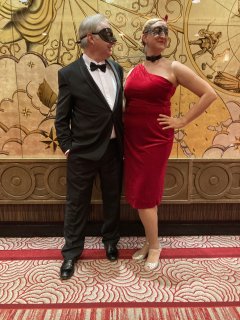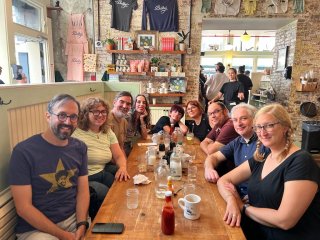I read 25 books in 2023. That’s exactly the same amount that I read in 2022.
15 of the 25 books were written by women—a bit of a dip from last year.
I read a lot more fiction than non-fiction this year. I’m okay with that.
There was plenty of sci-fi as usual, but 2023 was also the year I went down a rabbit hole of reading retellings of the Homeric epics. I’ve had a copy of The Odyssey on my coffee table while I’ve been diving into the works of Madeline Miller, Natalie Haynes, Pat Barker, and more. I’m really enjoying this deep dive and I don’t intend to stop anytime soon.
It’s funny; reading different takes on the same characters and interweaving storylines is kind of like dipping into the Marvel Cinematic Universe, just a few millennia older. In some ways, it feels like reading fantasy, but as Ursula Le Guin points out, things aren’t so black and white:
The Trojan war is not and you cannot make it be the War of Good vs. Evil. It’s just a war, a wasteful, useless, needless, stupid, protracted, cruel mess full of individual acts of courage, cowardice, nobility, betrayal, limb-hacking-off, and disembowelment. Homer was a Greek and might have been partial to the Greek side, but he had a sense of justice or balance that seems characteristically Greek—maybe his people learned a good deal of it from him? His impartiality is far from dispassionate; the story is a torrent of passionate actions, generous, despicable, magnificent, trivial. But it is unprejudiced. It isn’t Satan vs. Angels. It isn’t Holy Warriors vs. Infidels. It isn’t hobbits vs. orcs. It’s just people vs. people.
I’ve been reading some Ursula Le Guin this year too, and that’s something else I intend to keep on doing. Like the retellings of Troy, her work just keeps on giving.
Anyway, in my usual manner, here’s my end-of-year summary of what I’ve read, along with a pointless rating out of five.
To recap, here’s my scoring system:
- One star means a book is meh.
- Two stars means a book is perfectly fine.
- Three stars means a book is a good—consider it recommended.
- Four stars means a book is exceptional.
- Five stars is pretty much unheard of.
A nautical tale of The Great Hunger. It’s a tricky subject but this book mostly tackles it well. It’s fairly dripping in atmosphere.
★★★☆☆
Another rivetting tale from Nnedi Okorafor, this one set in a world that seems quite different from ours, where magic is a powerful force.
★★★☆☆
The second book in the trilogy—this time it’s war. Once again, the setting and the vibe are unlike any other alien invasion story. I’m looking forward to reading the final installment.
★★★☆☆
On the one hand, this book feels like homework because it really is required reading for any web designer or developer. On the other hand, Heather does an excellent job in making what could be a very dry topic as interesting as possible. The contrasts between the US and Europe are particulary eye-opening.
★★★☆☆
Absolutely top-notch hard sci-fi! It feels like two of the biggest characters in the book are time and evolution. For a tale that’s told over thousands of years, the pace never lets up. Now I get why this book won so many awards. It’s quite a feat of story-telling. I loved it!
★★★★☆
A fairly by-the-numbers retelling of the early days of computer hackers. To be honest, I found the pre-computer part (detailing telephone hacks) to be the most interesting bit.
★★☆☆☆
Circe by Madeline Miller
Everyone was going on about how great this book was so my expectations were high. They were exceeded. This book is just wonderful. When I finished it, I found myself craving more. That set me on the path of reading other retellings of Homeric characters, but none of them could quite match the brilliance of Circe.
★★★★☆
An assembly of speeches, memos, and emails. It’s refreshingly un-hagiographic, given the publisher. And of course it’s beautifully typeset.
★★★☆☆
After reading and loving Circe, I went back to Madeline Miller’s previous story of the Trojan War. The Song Of Achilles didn’t quite match Circe for me, but it came very close. Once again, everything is described vividly and once again, it stayed with me long after I finished reading it.
★★★★☆
Another retelling of the Trojan war. This is an episodic book that weaves its threads together nicely. Sometimes it’s a little on-the-nose about its intentions but it mostly works very well.
★★★☆☆
Le Guin’s first novel is far from her best work but it’s still better than most sci-fi. A good planetary romance.
★★★☆☆
Refreshingly level-headed and practical. If you work somewhere that’s considering using generative tools built on large language models, read this before doing anything.
★★★☆☆
The second of Le Guin’s Hainish books. Another planetary romance that’s perfectly fine but not in the same league as her later work.
★★★☆☆
The third of the Hainish novels, this one gets pretty trippy. I enjoyed the sensation of not knowing what was going on (much like the protaganist).
★★★☆☆
Babel by R.F. Kuang
This was such a frustrating read! On the one hand, the world-building as absolutely superb. The idea of magic being driven translation is brilliant. So is the depiction of a British empire that exploits and colonises foreign languages. But then the characters in this world are not well realised. The more the book went on, the less believable they seemed.
There’s also a really strange disconnect in the moods of the book; one minute it’s gritty revolutionary fare, the next it’s like Harry Potter goes to Oxford.
It didn’t work for me. And I know that my opinion can be easily dismissed as that of a mediocre middle-aged white man, but I really wanted to like this. I was totally on board with the politics of the book, but the way it hammered me over the head constantly didn’t do it any favours.
A message like “racism is bad” or “colonialism is bad” might work as subtext, but here, where it’s very much the text-text, it doesn’t succeed.
★★☆☆☆
A collection of short stories set in the west of Ireland. Good stuff.
★★★☆☆
Back to the Trojan war in the first of a series by Pat Barker. She takes a naturalistic tone with the dialogue, modernising it. It works quite well. By this time, having read Madeline Miller’s The Song Of Achilles and Natalie Hayne’s A Thousand Ships, I really felt like I was looking at the same series of events from different angles.
★★★☆☆
Another great accessible science book from Ed Yong, this time about senses in the animal world. It sometimes feels a bit like a series of articles rather than a single book, but when the articles are this good, that’s absolutely fine.
★★★☆☆
Okay, this might get a bit ranty…
The plot and the writing style in this book are perfectly fine, gripping even. It’s got that Gibsonesque structure of having two or three different characters in very different settings being propelled towards an inevitable meeting point (it happens pretty much exactly at the half-way point in this book).
But this is a cli-fi book that fails. It will not encourage anyone to take action other than turn into a doomer. Instead of asking what the future might actually be like, it instead asks “what’s the absolute worst that could happen?” Frankly, it’s a cop-out.
The book takes a similar tack with its characters. It assumes everyone’s terrible and will do terrible things. It’s lazy.
So you’ve got an unrelenting series of people behaving terribly in a horrific setting. It gets boring.
I was trying to cut the book some slack, but when there was a rare scene of actual consensual sex, it quickly turned into an adolescent male fantasy.
Reading this was like reading the opposite of Kim Stanley Robinson. Avoid.
★★☆☆☆
Back to Troy we go for the second in Pat Barker’s series. More good stuff.
★★★☆☆
A recommendation from Chris. He thought I’d enjoy this and he was not wrong. Tim Harford strikes just the right tone as he relays stories of statistics gone wrong as well as statistics done right.
★★★☆☆
I’ll read anything by Ann Leckie. I loved her Imperial Radch series and this book is set in the same universe. There’s a strange juxtaposition of body horror in places with a Becky Chambers style cosiness. It’s partly a courtroom drama, but one where the courtroom gets very dramatic indeed. And there are lots of questions around identity and belonging. I liked it.
★★★☆☆
Full disclosure: the author is a cousin of a friend of mine. She told me how much of this book was based on actual family history. It’s set in Belfast in the 70s and it is very vivid in a very kitchen-sink kind of way. It feels all-too real. Recommended.
★★★☆☆
The sequel to Children Of Time doesn’t quite hit the same high bar, but it’s still an excellent rip-roaring space adventure that continues the themes of evolution and time. Thoroughly enjoyable.
★★★☆☆
My final foray to ancient Greece for the year. This is a debut novel that’s absolutely on par with the other Homeric writers I’ve been reading. Even though you know where things are headed, you can’t turn away. In other words, it’s a classic Greek tragedy.
★★★☆☆
I had’t read any Joanna Russ before, which was something I’ve been meaning to rectify. I picked up a second-hand copy of this slim volume of short stories that was published by The Women’s Press back in the 80s but which is now out of print. Stories are vaguely connected and they all explore identity, gender, disguises and passing. But it’s the opening award-winning story Souls that’s the real stand-out. Well worth reading.
★★★☆☆
So that was my reading year. There were some disappointments in the sci-fi category, with both Babel and The Water Knife, but generally the quality was high.
I didn’t really read enough non-fiction to choose a best one of the year.
When it came to fiction, there was a clear winner: Circe by Madeline Miller.
If you fancy reading any of the books I’ve reviewed here, there’s a list of them on bookshop.org. Or go to your local library.
If you’re interested in my round-ups from previous years, here they are:




















